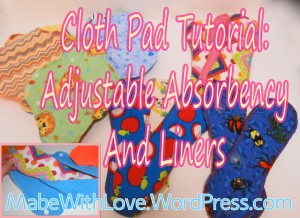 Hi again! In addition to our ‘pads three ways’ tutorials, I’m adding this adjustable absorbency pad and panty liner pattern. Like the other patterns, this pattern will be free.
Hi again! In addition to our ‘pads three ways’ tutorials, I’m adding this adjustable absorbency pad and panty liner pattern. Like the other patterns, this pattern will be free.
I’ll show you how to create an absorbent shell that can be used for light days or as a liner. We’ll also be creating wingless liners to add to the shell to boost absorbency or wear on their own.
What You’ll Need
- The pdf containing the patterns and tutorial: AdjustableAbsorbency&Liner. Please print the patterns actual size and DO NOT scale them down or ‘fit to page’.
- Fabric for the pad body top (shell): flannel, jersey, or any other cotton or absorbent material.
- Fabric for the pad body bottom (shell): anti-pill or blizzard fleece. These thicker fleece types naturally repel liquids and make a good water-resistant bottom while providing a non-slip surface against your underwear.
- Fabric for the pad core and liners. You want absorbent fabrics for your core. These could include cotton flannel, cotton birdseye, cotton terry cloth, bamboo, hemp, etc. Basically any thirsty fabric will work. Just remember that if you use microfiber or zorb, be sure to sandwich them between fabrics that are safe to be against the skin.
You may also want to add anti-pill or blizzard fleece as a bottom layer to some of the liners as this will help them to stay put in your underwear if you choose to wear them without the shell.Bamboo and hemp are good choices if you want a thinner pad as they are thin, but absorbent. 2-3 layers of bamboo or hemp will give you medium flow absorbency; use more for heavy, postpartum, or overnight.
If you use flannel, 6 layers would be a good medium flow. You would want to add more for heavier absorbencies. For the shells pictured, I have sewn a three layer flannel core into the shell. Each of the liners pictured have three layers of flannel as well for buildable absorbency.
- Sewing machine and notions (thread, needles, scissors, presser feet, etc)
- Snaps – metal or plastic. Plastic will be more durable, but metal may be easier to get. I have used KAM snaps here. They are really fantastic quality and the pliers are easy to use. I use a size 20 socket and stud, with size 16 snap caps.
Plastic snap pliers can all be found at JoAnn Fabric. I have seen metal snap pliers at Wal-Mart.
If you can’t find snaps, dry cleaners or alteration shops can often apply them. Or you can use Velcro or a diaper pin if you have to.
If you have a serger, obviously you can do all this on the serger as well. Learn more about cloth pads here. Happy sewing!
